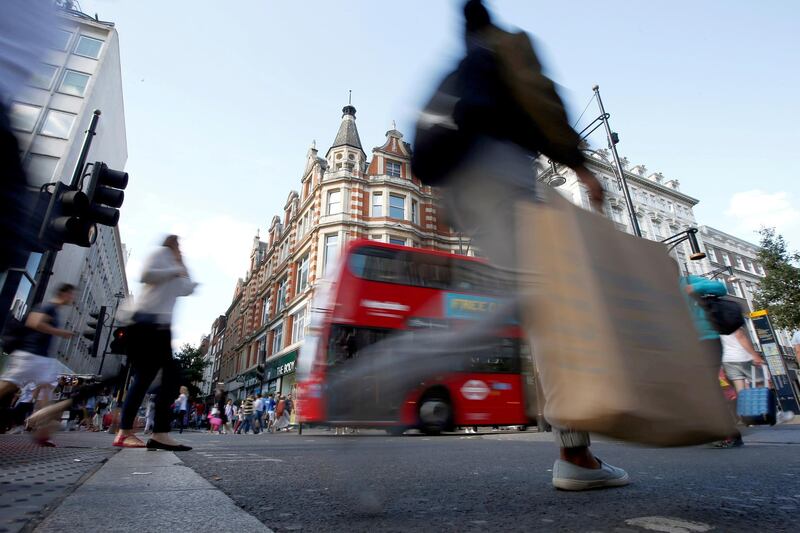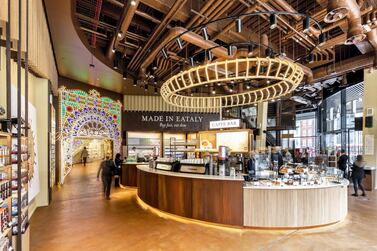Optimism about Britain’s economic recovery accelerated on Friday as a surge in business activity and soaring retail sales indicated the bounce-back could happen faster than expected, putting pressure on the Bank of England’s tightening policy.
A preliminary reading of the UK Composite Purchasing Managers' Index PMI, a gauge of economic growth, hit its highest level on record in May, rising to 62 from 60.7 in April, as many services firms reopened their doors and factories rode a wave of demand from a recovering global economy, prompting a jump in both hiring and prices. Any figure above 50 indicates an expansion.
Meanwhile, British retail sales soared 9.2 per cent in April on the month as consumers splurged on new clothes after shops reopened following months of lockdown closures in Britain, according to the Office for National Statistics, putting pressure on the BoE's cautious monetary policy approach.
Stuart Cole, head macroeconomist at brokerage Equiti Capital, said the BoE would be concerned that the “bounce-back could ultimately prove stronger than anticipated”, and that the Monetary Policy Committee’s cautious approach would see it “drift behind the policy curve”.
“They will be keeping a close eye on Gilt yields to see if the markets are starting to express this fear,” he said.
Britain's economy shrank by 9.8 per cent in 2020, when the country suffered its worst contraction in more than 300 years, one of the weakest performances among major global economies during the pandemic.
However, S&P Global Ratings said earlier this month that Britain’s sharp economic contraction last year would contribute to a stronger recovery in growth numbers this year and next.
"The UK is enjoying an unprecedented growth spurt as the economy reopens. Business confidence has meanwhile hit an all-time high as concerns about the impact of the pandemic continue to fade," said Chris Williamson, chief business economist at IHS Markit, which compiles the PMI survey.
"A direct consequence of demand running ahead of supply was a steep rise in prices, hinting strongly that consumer price inflation has much further to rise after lifting to 1.5 per cent in April."
Mr Williamson said the inflationary high could prove temporary, as many of the price increases reflected surcharges on shipping and other shortage-related issues linked to the pandemic.
However, a great deal of uncertainty remains as to how long it will take for global business and trade to return to normal functioning, especially if new virus variants appear, Mr Williamson said.
The stronger-than-expected retail sales in April, along with the sharp rise in business activity, came days after unemployment and inflation readings indicated an improving landscape, with unemployment falling to 4.8 per cent in March and inflation rising to 1.5 per cent in April, driven by a surge in consumer spending.
“The jigsaw puzzle pieces currently remain in place for a robust post-pandemic recovery this year, especially given that a further boost to activity will be provided by this week’s reopening of indoor restaurants and entertainment venues,” Mr Cole said.
The BoE upgraded its 2021 growth forecast this month to 7.5 per cent from 5 per cent, a move predicated largely on a strong bounce-back in consumption, but the positive economic data indicates that gross domestic product may accelerate even faster than the bank expects, putting its policy agenda under the spotlight.
Capital Economics said the central bank’s loosening phase is now over with the tightening phase closer, however, it does not expect the BoE to tighten monetary policy until 2024, rather than 2022 – the date indicated by the central bank.
The research company said language from the MPC's latest outlook indicated it would not make a move until the unemployment rate falls to 4.5 per cent in early 2023 and inflation stays above its 2 per cent target for a sustained period in late 2023 – with both conditions needing to be met at the same time.
“That implies that the MPC won't start tightening policy until 2024 at the earliest, much later than the bank forecasted,” said Paul Dales, chief UK economist at Capital Economics.
“We think an unwinding in quantitative easing in 2024 will probably be followed by some interest rate hike, probably a small one in 2025.”
Meanwhile, Britain’s surging retail sales in April, which followed a 5.1 per cent rise in March, means the volume is now 42.4 per cent higher than April last year when the UK was plunged into its first nationwide lockdown.
Our latest data show that retail sales increased by an estimated 9.2% in April 2021 compared with March 2021 https://t.co/bEdv1zRsd2 pic.twitter.com/BRdihEdrbX
— Office for National Statistics (ONS) (@ONS) May 21, 2021
The highest growth was in non-food retail with clothing sales in shops soaring by almost 70 per cent, while the proportion spent online dropped to 30 per cent, down from 34.7 per cent in March last year.
“Retail sales grew sharply in April and are now over 10 per cent above pre-pandemic levels as restrictions eased and more shops were able to open their doors,” said Jonathan Athow, deputy statistician at the ONS.
“Clothing sales soared by nearly three quarters as consumers took advantage of being able to visit physical stores. Perhaps unsurprisingly, overall online sales dipped but still remain high.”
Fuel sales increased again this month but remain below the pre-pandemic level, because although more people are travelling, many are still working from home.
Britain's retailers were hit hard by the pandemic with shops in particular affected by closures during three lockdowns in England. The latest shutdown saw non-essential shops in England close from early January until April 12.
The reopening helped Britain's longest-running survey of consumer sentiment, from GfK, return to its March 2020 level before Britain felt the full force of the Covid-19 pandemic.
Naeem Aslam, chief market analyst at Think Markets, said Britain’s retail rebound led to the pound ticking higher against the dollar and euro on Friday morning, continuing an upward surge over the past few weeks during which the currency has risen 3.6 per cent in dollar terms since April 9.
“The British pound, which was already trading higher against the dollar, is firing on all cylinders on the back of the UK’s retail sales data,” Mr Aslam said.
The "astonishing" surge in clothing and footwear sales in April "showed that households were particularly keen to update their wardrobes", said Mr Dales.
While there was less scope now for major gains in retail, Mr Dales said recent data suggested people returning to restaurants, cinemas and theatres drove May’s economic recovery.
Meanwhile, fewer virtual baskets were filled, with online spending dropping 5.6 per cent in April as real shopping trips took over from the trend of digital browsing from the comfort of the sofa, said Susannah Streeter, senior investment and markets analyst at Hargreaves Lansdown.
“With hospitality reopening after the Easter break, it sucked grocery spend away from supermarkets and into the tills of restaurants and cafes,” she said.
Helen Dickinson, chief executive of the British Retail Consortium, said demand remains fragile, despite building up during lockdown.
Footfall is still down by 40 per cent on the pre-pandemic period, she said, and 530,000 people who work in retail are still on furlough.
"The end of the full business rates relief in England poses a significant threat to retailers who have spent well over £1 billion ($1.41bn) on Covid-secure measures aimed at protecting staff and customers," Ms Dickinson said.
"The government must deliver on its promise to reform the broken business rates system in their ongoing review."








